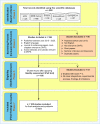Deep Neuro-Fuzzy System application trends, challenges, and future perspectives: a systematic survey
- PMID: 35431395
- PMCID: PMC9005344
- DOI: 10.1007/s10462-022-10188-3
Deep Neuro-Fuzzy System application trends, challenges, and future perspectives: a systematic survey
Abstract
Deep neural networks (DNN) have remarkably progressed in applications involving large and complex datasets but have been criticized as a black-box. This downside has recently become a motivation for the research community to pursue the ideas of hybrid approaches, resulting in novel hybrid systems classified as deep neuro-fuzzy systems (DNFS). Studies regarding the implementation of DNFS have rapidly increased in the domains of computing, healthcare, transportation, and finance with high interpretability and reasonable accuracy. However, relatively few survey studies have been found in the literature to provide a comprehensive insight into this domain. Therefore, this study aims to perform a systematic review to evaluate the current progress, trends, arising issues, research gaps, challenges, and future scope related to DNFS studies. A study mapping process was prepared to guide a systematic search for publications related to DNFS published between 2015 and 2020 using five established scientific directories. As a result, a total of 105 studies were identified and critically analyzed to address research questions with the objectives: (i) to understand the concept of DNFS; (ii) to find out DNFS optimization methods; (iii) to visualize the intensity of work carried out in DNFS domain; and (iv) to highlight DNFS application subjects and domains. We believe that this study provides up-to-date guidance for future research in the DNFS domain, allowing for more effective advancement in techniques and processes. The analysis made in this review proves that DNFS-based research is actively growing with a substantial implementation and application scope in the future.
Keywords: Big data; Classification systems; Deep neural network; Deep neuro-fuzzy systems; Fuzzy systems; Optimization methods.
© The Author(s), under exclusive licence to Springer Nature B.V. 2022.
Figures






















References
-
- Abraham A (2001) Neuro fuzzy systems: state-of-the-art modeling techniques. In: Paper presented at the connectionist models of neurons, learning processes, and artificial intelligence, Berlin, Heidelberg
-
- Almuammar M, Fasli M (2019) Deep learning for non-stationary multivariate time series forecasting. In: 2019 IEEE international conference on big data (Big Data), pp 2097–2106. 10.1109/BigData47090.2019.9006192
-
- Amosov OS, Ivanov YS, Amosova SG (2019) Recognition of abnormal traffic using deep neural networks and fuzzy logic. In: 2019 international multi-conference on industrial engineering and modern technologies (FarEastCon), pp 01–05. 10.1109/FarEastCon.2019.8934327
-
- An J, Fu L, Hu M, Chen W, Zhan J. A novel fuzzy-based convolutional neural network method to traffic flow prediction with uncertain traffic accident information. IEEE Access. 2019;7:20708–20722. doi: 10.1109/ACCESS.2019.2896913. - DOI
-
- Angelov PP, Gu X. Deep rule-based classifier with human-level performance and characteristics. Inf Sci. 2018;463–464:196–213. doi: 10.1016/j.ins.2018.06.048. - DOI
LinkOut - more resources
Full Text Sources
Research Materials
